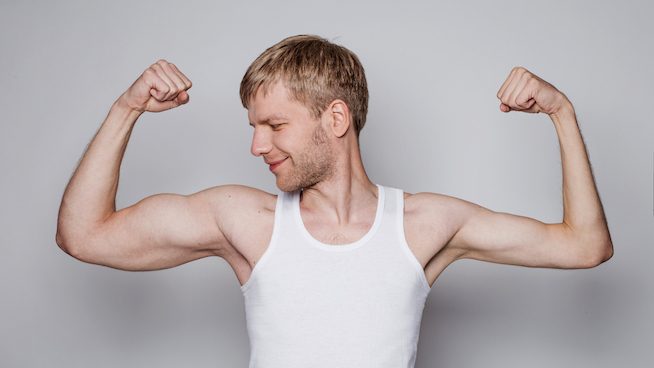What Should I Do if One Side of My Body Is Stronger Than the Other?
We strive to be creatures of symmetry.
Yet imbalances are all but unavoidable. And every day, we reinforce many of our body’s physical imbalances through seemingly innocuous habits.
We brush our teeth with the same hand every night. We carry our bags over the same shoulder every morning. We favor the same side every time we get up from our desks.
Over time, these repetitive actions result in some parts of our bodies being stronger and more coordinated than other parts of our bodies. Injuries often exacerbate the issue. Although every person can benefit from eliminating or reducing muscle asymmetries, it’s especially important for athletes.
Almost everyone feels that one side of their body is stronger than the other. A right-handed person will often feel the right side of their body is stronger than the left. Since we use our dominant hand to perform the majority of tasks, this makes sense. However, too much of an imbalance can inhibit your performance and increase your risk of injury. If you feel one side of your body is lagging behind, here’s what you can do about it.
One of the easiest ways to identify a potential side-to-side imbalance is to watch someone Barbell Bench Press. Once the weight becomes challenging, you’ll often notice that one half of the bar is moving more easily than the other side. The dominant side is doing more work. If the person is right-handed, odds are the right side of the barbell will rise with more speed and more control than the left side. They eventually complete the set, but there’s no doubt that one side of their body was doing more work than the other. Unless these imbalances are addressed, the gap between strong and weak continues to grow, further increasing the likelihood of injury and body asymmetries.
So what can we do about it?
Our first task is to change the way we think about strength training. Most of us can lift heavy weight with two arms (Bench Press, Pull-Up, etc.) or two legs (Squat, Deadlift, etc.). Most popular exercises are bilateral in nature, meaning we use both of our limbs (left and right) together to complete them. Bilateral training is great for building strength, but not-so-great for addressing imbalances. So to reduce the imbalance, we need to shift our focus from training bilaterally to training unilaterally.
Unilateral training means each limb is responsible for doing its own work. Think of a Single-Leg Split Squat as opposed to a traditional Squat. Unilateral exercises force each limb to work independently. This fact alone is what makes them so good for destroying muscle asymmetries. Unilateral training will also help you quickly identify where your imbalances lie, and many of its qualities transfer better to sport than bilateral training. While unilateral training is certainly possible via the use of barbells and machines, many of the exercises make use of dumbbells, kettlebells, cables and resistance bands.
Increasing your use of unilateral exercises is easier said than done. Once you’ve established a base level of strength, you should ask yourself four questions:
- How can I apply unilateral training principles to my program?
- What substitutions can I make to work unilaterally?
- Am I willing to lift less weight for better overall performance?
- Am I willing to take a step back to take two steps forward?
Let’s use the Barbell Bench Press example again. A great unilateral substitution is a Single-Arm Dumbbell Bench Press. The motion is the same as a regular Bench Press, except the use of a single dumbbell allows you to isolate the movement on one side at a time. From this position, we can feel our weaknesses. If our right side cranks out 10 reps with a 50-pound dumbbell, but our left side can only do 6 reps, we have a clear example of muscular imbalance.
But identifying the imbalance is just the first step in your battle. From that point forward, you should continue to utilize the Single-Arm Dumbbell Bench Press in your training. You should also start each set on the weaker side (so in this case, the left side), and only perform as many reps with your strong hand as you did with your weaker hand. Then, use these same principles with all of the unilateral exercises you include in your training. So if your left leg is weaker than your right leg, perform Lunges with your left leg first in each set, and then only perform as many reps with your right leg as you did with your left leg. It’s not rocket science, but these simple principles will help expedite the process and destroy the imbalance quicker.
There are a ton more benefits to unilateral training aside from simply destroying imbalances. Since it requires us to stabilize an uneven load, we recruit more stabilizer muscles during unilateral training. Almost every athletic action is performed off one foot, further solidifying the benefit of this type of training. However, you cannot move as much weight during unilateral exercises as you can during bilateral exercises, as two limbs are obviously stronger than one. Bilateral exercises can also force you to develop greater amounts of core strength to support those heavier loads. This article examines the differences between bilateral and unilateral training, but in a well-designed program, both bilateral and unilateral exercises should be utilized. The ratio of bilateral to unilateral depends on the individual’s sport and performance goals, but if you’ve long found one side of your body to be weaker than the other, you could likely benefit from including some more unilateral training in your routine.
Here are some ideas on how you can take traditional bilateral exercises and turn them into unilateral movements.
Strength Exercises
- Bench Press—Single-Arm Dumbbell Row
- Pull-Ups—Single-Arm Vertical Cable Row
- Squats—Single-Leg Split Squats, Pistol Squats, Step-Ups, Lunges
- Deadlifts—Single-Leg Deadlifts
Power Exercises
- Hang or Power Clean—Single-Arm Kettlebell Clean
- Hang or Power Snatch—Single-Arm Dumbbell Snatch, Single-Arm Kettlebell Snatch
- Push Press—Single-Arm Dumbbell Push Press, Single-arm Kettlebell Push Press
In the above listed substitutions, the unilateral focus allows each side of the body to work independently of the other. It encourages the left and right side to become more coordinated and promotes mind-muscle communication: the brain must tell which limb to do which job at which time. Athletic gains will be achieved by having a better balanced, more coordinated body.
It’s also worth investigating if your flexibility and mobility are significantly better on one side of your body than the other. If they are, that could also be holding back one side of your body and adding to this imbalance. A thorough warm-up that targets many common flexibility and mobility limitations, such as this one from STACK expert John Papp, can go a long way toward addressing these issues.
Photo Credit: IndigoLT/iStock
READ MORE:
RECOMMENDED FOR YOU
MOST POPULAR
What Should I Do if One Side of My Body Is Stronger Than the Other?
We strive to be creatures of symmetry.
Yet imbalances are all but unavoidable. And every day, we reinforce many of our body’s physical imbalances through seemingly innocuous habits.
We brush our teeth with the same hand every night. We carry our bags over the same shoulder every morning. We favor the same side every time we get up from our desks.
Over time, these repetitive actions result in some parts of our bodies being stronger and more coordinated than other parts of our bodies. Injuries often exacerbate the issue. Although every person can benefit from eliminating or reducing muscle asymmetries, it’s especially important for athletes.
Almost everyone feels that one side of their body is stronger than the other. A right-handed person will often feel the right side of their body is stronger than the left. Since we use our dominant hand to perform the majority of tasks, this makes sense. However, too much of an imbalance can inhibit your performance and increase your risk of injury. If you feel one side of your body is lagging behind, here’s what you can do about it.
One of the easiest ways to identify a potential side-to-side imbalance is to watch someone Barbell Bench Press. Once the weight becomes challenging, you’ll often notice that one half of the bar is moving more easily than the other side. The dominant side is doing more work. If the person is right-handed, odds are the right side of the barbell will rise with more speed and more control than the left side. They eventually complete the set, but there’s no doubt that one side of their body was doing more work than the other. Unless these imbalances are addressed, the gap between strong and weak continues to grow, further increasing the likelihood of injury and body asymmetries.
So what can we do about it?
Our first task is to change the way we think about strength training. Most of us can lift heavy weight with two arms (Bench Press, Pull-Up, etc.) or two legs (Squat, Deadlift, etc.). Most popular exercises are bilateral in nature, meaning we use both of our limbs (left and right) together to complete them. Bilateral training is great for building strength, but not-so-great for addressing imbalances. So to reduce the imbalance, we need to shift our focus from training bilaterally to training unilaterally.
Unilateral training means each limb is responsible for doing its own work. Think of a Single-Leg Split Squat as opposed to a traditional Squat. Unilateral exercises force each limb to work independently. This fact alone is what makes them so good for destroying muscle asymmetries. Unilateral training will also help you quickly identify where your imbalances lie, and many of its qualities transfer better to sport than bilateral training. While unilateral training is certainly possible via the use of barbells and machines, many of the exercises make use of dumbbells, kettlebells, cables and resistance bands.
Increasing your use of unilateral exercises is easier said than done. Once you’ve established a base level of strength, you should ask yourself four questions:
- How can I apply unilateral training principles to my program?
- What substitutions can I make to work unilaterally?
- Am I willing to lift less weight for better overall performance?
- Am I willing to take a step back to take two steps forward?
Let’s use the Barbell Bench Press example again. A great unilateral substitution is a Single-Arm Dumbbell Bench Press. The motion is the same as a regular Bench Press, except the use of a single dumbbell allows you to isolate the movement on one side at a time. From this position, we can feel our weaknesses. If our right side cranks out 10 reps with a 50-pound dumbbell, but our left side can only do 6 reps, we have a clear example of muscular imbalance.
But identifying the imbalance is just the first step in your battle. From that point forward, you should continue to utilize the Single-Arm Dumbbell Bench Press in your training. You should also start each set on the weaker side (so in this case, the left side), and only perform as many reps with your strong hand as you did with your weaker hand. Then, use these same principles with all of the unilateral exercises you include in your training. So if your left leg is weaker than your right leg, perform Lunges with your left leg first in each set, and then only perform as many reps with your right leg as you did with your left leg. It’s not rocket science, but these simple principles will help expedite the process and destroy the imbalance quicker.
There are a ton more benefits to unilateral training aside from simply destroying imbalances. Since it requires us to stabilize an uneven load, we recruit more stabilizer muscles during unilateral training. Almost every athletic action is performed off one foot, further solidifying the benefit of this type of training. However, you cannot move as much weight during unilateral exercises as you can during bilateral exercises, as two limbs are obviously stronger than one. Bilateral exercises can also force you to develop greater amounts of core strength to support those heavier loads. This article examines the differences between bilateral and unilateral training, but in a well-designed program, both bilateral and unilateral exercises should be utilized. The ratio of bilateral to unilateral depends on the individual’s sport and performance goals, but if you’ve long found one side of your body to be weaker than the other, you could likely benefit from including some more unilateral training in your routine.
Here are some ideas on how you can take traditional bilateral exercises and turn them into unilateral movements.
Strength Exercises
- Bench Press—Single-Arm Dumbbell Row
- Pull-Ups—Single-Arm Vertical Cable Row
- Squats—Single-Leg Split Squats, Pistol Squats, Step-Ups, Lunges
- Deadlifts—Single-Leg Deadlifts
Power Exercises
- Hang or Power Clean—Single-Arm Kettlebell Clean
- Hang or Power Snatch—Single-Arm Dumbbell Snatch, Single-Arm Kettlebell Snatch
- Push Press—Single-Arm Dumbbell Push Press, Single-arm Kettlebell Push Press
In the above listed substitutions, the unilateral focus allows each side of the body to work independently of the other. It encourages the left and right side to become more coordinated and promotes mind-muscle communication: the brain must tell which limb to do which job at which time. Athletic gains will be achieved by having a better balanced, more coordinated body.
It’s also worth investigating if your flexibility and mobility are significantly better on one side of your body than the other. If they are, that could also be holding back one side of your body and adding to this imbalance. A thorough warm-up that targets many common flexibility and mobility limitations, such as this one from STACK expert John Papp, can go a long way toward addressing these issues.
Photo Credit: IndigoLT/iStock
READ MORE:











